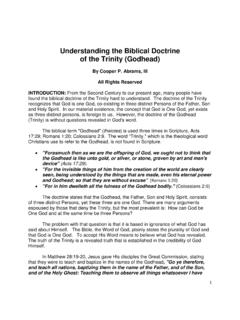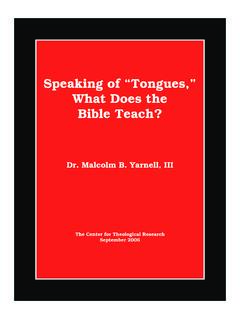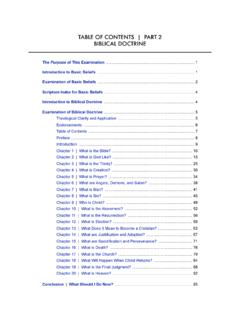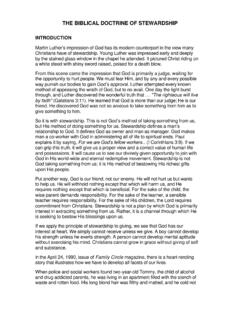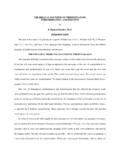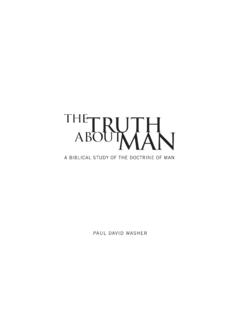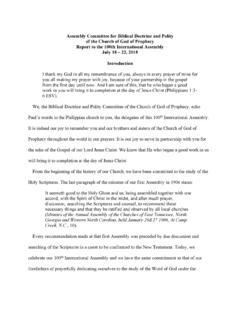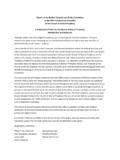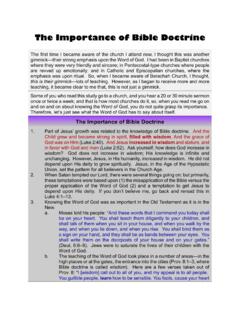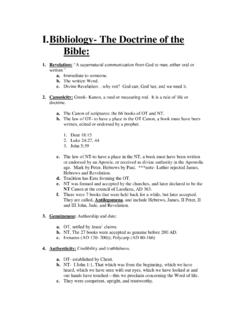Transcription of B.B. Warfield, “Trinity,” from the International Standard ...
1 1 Warfield, Trinity, from the International Standard Bible Encyclopedia (general editor James Orr), 1915 This classic piece is often republished as The biblical Doctrine of the Trinity (for instance, in the volume of The Works of B. B. Warfield), but in a format that flattens some of the features that make it more readable and interesting. The web versions are espeically flat. This study edition restores those features. The two sizes of fonts are especially important: some paragraphs are digressions and should be flagged as such. In its ISBE form, the essay also began with a 22-heading outline, each heading of which was also inset into the text at the appropriate places. In the right column I have added my own comments on the text. These comments sometimes provide definitions, background, or sources.
2 But severalof them distinguish where Warfield is being traditional from where he is being original. They generally indicate enthusiastic agreement in the early sections, and more disagreement in the later sections. Generally, I take this essay to be a powerful commentary on how the doctrine of the Trinity is made known in Scripture, but a quirky departure from classical standards of doctrine as it tends to undermine the relations of origin (eternal begetting and procesion). The article is about 15,000 words (20 columns in the encyclopedia). #page/n207/mode/2up 12. Spirit in Johannine Discourses 13. The Baptismal Formula 14. Genuineness of Baptismal Formula 15. Paul s Trinitarianism 16. Conjunction of the Three in Paul 17. Trinitarianism of Other NT Writers 18. Variations in Nomenclature 19. Implications of Son and Spirit 20.
3 The Question of Subordination 21. Witness of the Christian Consciousness 22. Formulation of the Doctrine 1. The Term Trinity 2. Purely a Revealed Doctrine 3. No Rational Proof of It 4. Finds Support in Reason 5. Not Clearly Revealed in the OT 6. Prepared for in the OT 7. Presupposed Rather than Inculcated in the NT 8. Revealed in Manifestation of Son and Spirit 9. Implied in the Whole NT 10. Conditions the Whole Teaching of Jesus 11. Father and Son in Johannine Discourses Table of Contents Fred Sanders Updated Oct 2015 2 The term Trinity is not a biblical term, and we are not using biblical language when we define what is expressed by it as the doctrine that there is one only and true God, but in the unity of the Godhead there are three coeternal and coequal Persons, the same in substance but distinct in subsistence.
4 A doctrine so defined can be spoken of as a biblical doctrine only on the principle that the sense of Scripture is Scripture. And the definition of a biblical doctrine in such unbiblical language can be justified only on the principle that it is better to preserve the truth of Scripture than the words of Scripture. The doctrine of the Trinity lies in Scripture in solution; when it is crystallized from its solvent it does not cease to be Scriptural, but only comes into clearer view. Or, to speak without figure, the doctrine of the Trinity is given to us in Scripture, not in formulated definition, but in fragmentary allusions; when we assembled the disjecta membra into their organic unity, we are not passing from Scripture, but entering more thoroughly into the meaning of Scripture.
5 We may state the doctrine in technical terms, supplied by philosophical reflection; but the doctrine stated is a genuinely Scriptural doctrine. In point of fact, the doctrine of the Trinity is purely a revealed doctrine. That is to say, it embodies a truth which has never been discovered, and is indiscoverable, by natural reason. With all his searching, man has not been able to find out for himself the deepest things of God. Accordingly, ethnic thought has never attained a Trinitarian conception of God, nor does any ethnic religion present in its representations of the Divine Being any analogy to the doctrine of the Trinity. Triads of divinities, no doubt, occur in nearly all polytheistic religions, formed under very various influences. Sometimes as in the Egyptian triad of Osiris, Isis and Horus, it is the analogy of the human family with its father, mother and son which lies at their basis.
6 Sometimes they are the effect of mere syncretism, three deities worshipped in different localities being brought together in the common worship of all. Sometimes, as in the Hindu triad of Brahma, Vishnu and Shiva, they represent the cyclic movement of a pantheistic evolution, and symbolize the three stages of Being, Becoming and Dissolution. Sometimes they are the result apparently of nothing more than an odd human tendency to think in threes, which has given the number three widespread standing as a sacred number (so H. Usener). It is no more than was to be anticipated, that one or another of these triads should now and again be pointed to as the replica (or even the original) of the Christian doctrine of the Trinity.
7 Gladstone found the Trinity in the Homeric mythology, the trident of Poseidon being its symbol. Hegel very naturally found it in the Hindu Trimurti, which indeed is very like his pantheizing notion of what the Trinity is. Others have perceived it in the Buddhist Triratna (S derblom); or (despite their crass dualism) in some speculations of Parseeism; or, more frequently, in the notional triad of Platonism (e. g., Knapp); while Jules Martin is quite sure that it is present in Philo's neo-Stoical doctrine of the "powers," especially when applied to the explanation of Abraham's three visitors. Of late years, eyes have been turned rather to Babylonia; and H. Zimmern finds a possible forerunner of the Trinity in a Father, Son, and Intercessor, which he discovers in its mythology.
8 It should be needless to say that none of these triads has the slightest resemblance to the Christian doctrine of the Trinity. The Christian doctrine of the 1. The Term Trinity 2. Purely a Revealed Doctrine Disjecta membra, meaning scattered parts, is from Horace (Satires I, 4, 62). Job 11:7, Can you find out the deep things of God? Can you find out the limit of the Almighty? 1 Cor 2:10: But unto us God revealed them through the Spirit: for the Spirit searcheth all things, yea, the deep things of God. W. has already announced that the study of ethnic thought does not yield a discovery of the Trinity. Here in small print he reviews the evidence. There was a vast amount of this literature in the 19th century, the high water mark of comparative religion. Fascinating, but don t get distracted. Hermann Usener (1834-1905) Dreiheit: Ein Versuch mythologischer Zahlenlehre (Bonn: 1903) Originally issued as Rheinisches Museum f r Philologie, n.
9 F. Bd. 58, 1-48, 161-208, 321-364. Heinrich Zimmern, Vater, Sohn, und Fuersprecher in der Babylonischen Gottesvorstellung: Ein Problem fur die Vergleichende Religionswissenschaft (Leipzig: 1896) You re writing for a Bible Encyclopedia, and you ve been assigned Trinity. Your opening move is to say it is not a biblical term, and then to justify your existence. ethnic thought = what we would call world religions and the philosophies of many cultures. Is there an Egyptian Trinity, or a Buddhist Trinity, See below. Better to preserve the truth than the words: This is the approach constantly defended by Turretin. It is one thing to be in Scripture according to sound (quoad sonum) and another to be in Scripture according to meaning (quoad sensum). Inst. theol., William Ewart Gladstone, Juventus Mundi: The Gods and Men of the Heroic Age (1869), p.
10 252. A brief, passing remark. See Hegel, Lectures on the Philosophy of Religion, Vol II: Determinate Religion, ed Peter Hodgson (University of California Press, 1987), p. 327ff. S derblom, Knapp, Martin, etc: See, there s a lot of this stuff. You really could skip to section 5 now. If you read 2-4, be sure to bear in mind that this is a digression, dealing in advance with false starts. Once they are cleared away, Warfield will proceed with his actual argument. 3 Trinity embodies much more than the notion of "threeness," and beyond their "threeness" these triads have nothing in common with it. As the doctrine of the Trinity is indiscoverable by reason, so it is incapable of proof from reason. There are no analogies to it in Nature, not even in the spiritual nature of man, who is made in the image of God.
